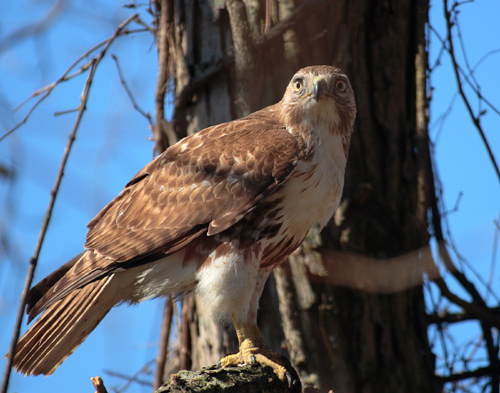The red-tailed hawk is a well-known hawk. These birds are variable shades of brown with white breasts and the rust-colored, fanned tails that give them their name. The tail is only rusty-colored on top and isn't easily seen in-flight. They have rounded, broad wings and a dark band on their belly. The adults can weigh an average of 2 1/2 pounds and their wingspans are generally around 4 feet.
Red-tailed hawks, like many raptors, were impacted by the common use of the pesticide DDT in the mid 20th century that contaminated the food chain. The chemical caused the egg shells produced by many birds to be weakened to the point that the eggs just broke rather than surviving incubation. DDT was banned in 1972. The ban along with conservation measures have helped many raptor populations to recover.
Red-tailed hawks are year-round residents all through the US and in northern Mexico. Some red-tails stay put and some migrate to southern areas in winter. In summer they extend their range up through southern Canada and southeastern Alaska.
In Connecticut, red-tailed hawks are common.
Red-tailed hawks use open fields and meadows for hunting and tall trees for nesting. They like to live in forests near open areas. These hawks are active during the day and are adept soarers.
These hawks will feed on small rodents, smaller birds, reptiles, and amphibians. They usually locate prey with vision from a high perch and swoop down to capture it in their talons.
In New England red-tailed hawks breed beginning in about March. A male and female pair will perfom aerial acrobatics as a form of courtship. The two hawks mate for life, although if one dies the other will seek another mate. They use the same nesting areas for years. They can build new nests out of sticks or repair existing ones, and prefer to nest high, around 50 or 60 feet above the ground, in tall trees or on cliffs. 1 to 4 eggs are laid in late March or April. The male will do some of the incubation, but mostly feeds the female while she sits on the nest. Both care for the chicks which hatch out after about 33 days. The baby hawks can fly in 43 to 48 days. Their parents teach them hunting skills and they become independent after about 2 months. The lifespan of red-tailed hawls is about 13 to 20 years in the wild.
